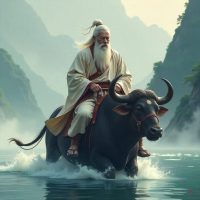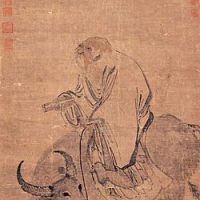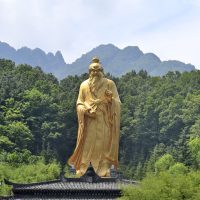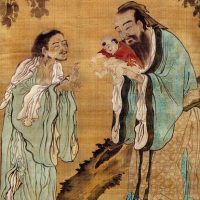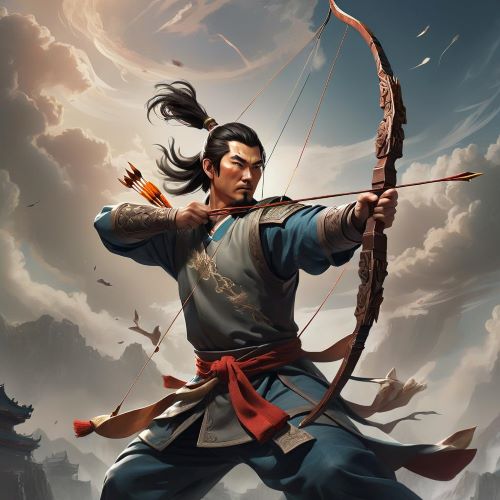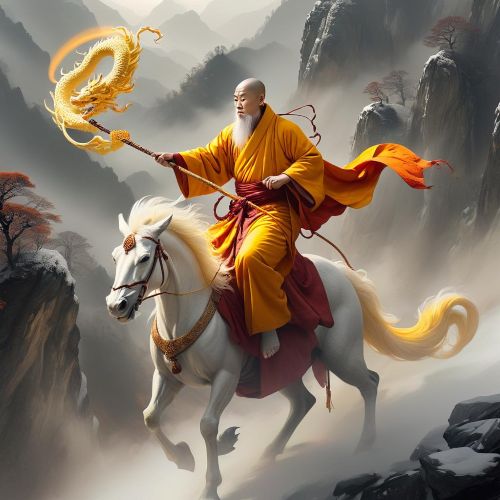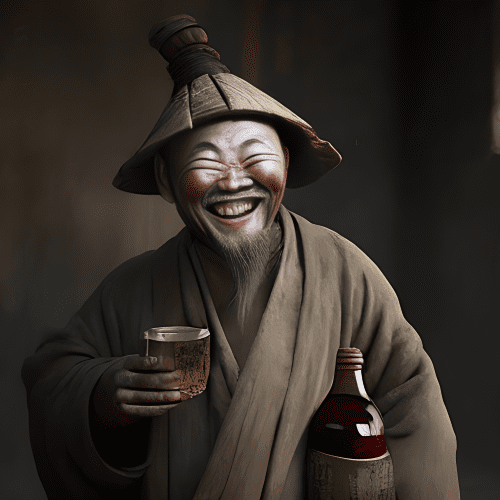Laozi : The Chinese Sage of the Dao
Listen
At a glance
| Description | |
|---|---|
| Origin | Chinese Mythology |
| Classification | Mortals |
| Family Members | N/A |
| Region | China |
| Associated With | Philosophy |
Laozi
Introduction
Laozi stands as one of the most influential figures in Chinese philosophy and mythology, celebrated as the author of the Daodejing and the founding sage of Daoism. His presence in early Chinese history blends mythic depth with philosophical brilliance, making him a figure who straddles both human and divine realms. Laozi is traditionally placed in the 6th century BCE, though some scholars argue he may have lived closer to the 4th century BCE, during the Warring States period. Regardless of the exact date, his teachings shaped the foundations of Daoist thought, advocating a life aligned with the Dao—an ineffable cosmic principle underlying all existence. His emphasis on wu wei, or effortless action, transformed Chinese views on leadership, ethics, natural balance, and the human relationship with the universe. In Daoist religion, he is further elevated as Taishang Laojun, the Supreme Old Lord, a celestial being guiding the cosmos with quiet wisdom.
Physical Traits
Descriptions of Laozi’s appearance communicate symbolic meaning rather than historically verified detail. Classical accounts depict him as an elderly sage, his long white beard representing accumulated wisdom and spiritual maturity. His serene expression mirrors the Daoist ideal of inner stillness and clarity. Traditional iconography often shows him dressed in simple, flowing robes, highlighting his rejection of material excess and attachment. A recurring image features him seated upon or riding a water buffalo—an animal associated with humility, patience, and harmony with nature. These depictions reinforce his identity as a teacher who understood the rhythms of the natural world and lived in accordance with its subtleties.
Family
Historical documents provide very limited information about Laozi’s family life, leading mythological traditions to fill in the gaps with symbolic stories. According to legend, his mother conceived him after witnessing a falling star, marking him as a child destined for spiritual greatness. The myth of his extended gestation—lasting between 62 and 81 years—emphasizes his extraordinary origin and timeless wisdom. He was said to be born near a plum tree and was thus associated with the surname Li, which eventually became the family name of the Tang dynasty, whose rulers claimed Laozi as a divine ancestor. Whether or not he had a spouse or children remains unknown, but his symbolic importance as the cultural progenitor of the Li lineage had significant influence on later imperial mythology and identity.
Other names
Laozi is known by a wide range of names that reflect the many roles he plays in Chinese philosophy, mythology, and religion. His personal name, Li Er, appears in early texts such as the Records of the Grand Historian. He is also called Lao Dan, a name that may reference his elder appearance. In religious Daoism, he holds exalted titles such as Lao Jun (Old Lord) and Taishang Laojun (Grand Supreme Elder Lord), which position him not merely as a philosopher but as a high celestial deity. As one of the Three Pure Ones—specifically Daode Tianzun, the Celestial Venerable of the Way and Its Virtue—he occupies one of the highest positions in the Daoist divine hierarchy. These names illustrate how Laozi evolved from a historical thinker into a mythic and godlike figure within Chinese spiritual tradition.
Powers and Abilities
Within mythology, Laozi’s abilities reflect his intimate connection with the Dao, portraying him as a being whose wisdom transcends earthly limitations. Daoist tradition regards him as immortal, capable of existing throughout countless epochs to guide humanity whenever the cosmic balance requires restoration. Numerous legends describe him performing transformations, appearing in different forms or eras to deliver teachings aligned with the Dao. His spiritual authority enables him to harmonize realms of existence, articulating truths that maintain equilibrium between heaven, earth, and humanity. Stories recount his departure from China toward the West, during which he wrote the Daodejing at a border pass before continuing his journey into the unknown, symbolizing his mastery of transcendence and detachment. In religious practice, his divine form protects cosmic order and preserves the moral harmony of the universe.
Modern Day Influence
Laozi’s impact extends across centuries, influencing global spirituality, philosophy, arts, and environmental thought. The Daodejing remains one of the most translated books in world history and continues to shape discussions on leadership, governance, inner peace, and the nature of existence. His principle of wu wei resonates strongly in modern mindfulness and wellness practices, where living without forced effort aligns with contemporary mental health and self-development approaches. Environmental thinkers frequently draw on Laozi’s teachings about harmony with nature as a framework for sustainable living. In literature and visual arts, his imagery—particularly the sage on the water buffalo—remains a powerful cultural symbol. Scholars across fields such as philosophy, sinology, comparative religion, and political theory continue to study Laozi’s work for its depth, ambiguity, and timeless relevance. His legacy persists as a vital influence on how the modern world understands balance, simplicity, and the flow of life.
Related Images
Source
Britannica, T. Editors of Encyclopaedia (1998). Laozi | Biography, Philosophy, Beliefs, & Facts. Encyclopedia Britannica. https://www.britannica.com/biography/Laozi
World History Encyclopedia (2020). Lao-Tzu. https://www.worldhistory.org/Lao-Tzu/
Kohn, L. (1996). The Looks of Laozi. Asian Ethnology, 55(1), 23-42. https://asianethnology.org/downloads/ae/pdf/a1127.pdf
Kohn, Livia. (2025). Laozi. In Internet Encyclopedia of Philosophy. https://iep.utm.edu/laozi/
Stanford Encyclopedia of Philosophy (2021). Laozi (Summer 2021 Edition). https://plato.stanford.edu/archives/sum2021/entries/laozi/
The Philosopher (2024). Lao Tzu Biography, Lao Tzu biography read, Lao Tzu biography. https://thephilosopher.net/laotzu/
Kaltenmark, M. (1969). Lao Tzu and Taoism. Stanford University Press.
Robinet, I. (1997). Taoism: Growth of a Religion. Stanford University Press.
Kohn, L. (1998). Daoism Handbook. Brill Academic Publishers.
Chan, W.‑T. (1963). A Source Book in Chinese Philosophy. Princeton University Press.
Graham, A. C. (1989). Disputers of the Tao: Philosophical Argument in Ancient China. Open Court Publishing.
Frequently Asked Questions
Who was Laozi in Chinese mythology?
Laozi is revered as the legendary founder of Daoism and the author of the Daodejing, blending historical and divine identities within Chinese tradition.
What did Laozi teach in the Daodejing?
Laozi emphasized harmony with the Dao, simplicity, balance, and the practice of wu wei, or effortless action.
Was Laozi a real historical figure?
Many scholars debate his historicity, with some viewing him as a real philosopher and others as a symbolic or composite figure.
Why is Laozi often depicted riding a buffalo?
The buffalo symbolizes humility and harmony with nature, reflecting Daoist ideals that Laozi embodied.
How does Laozi influence modern culture?
His teachings continue to shape global philosophy, environmental ethics, mindfulness practices, leadership theory, and literature.


